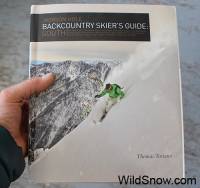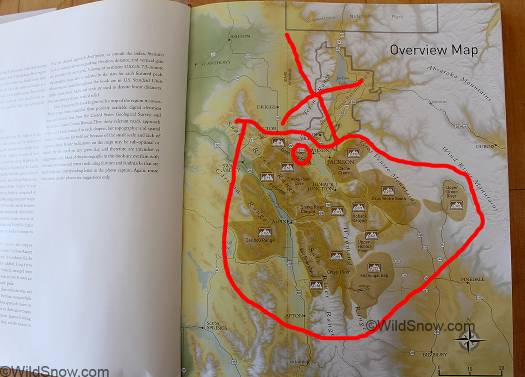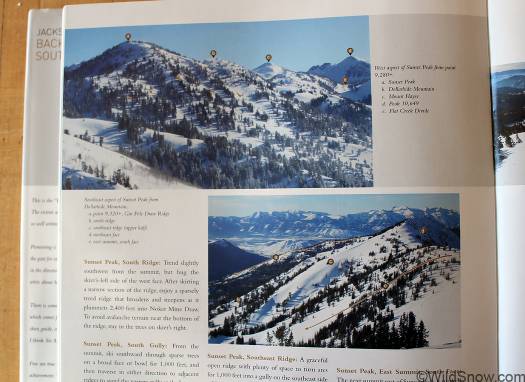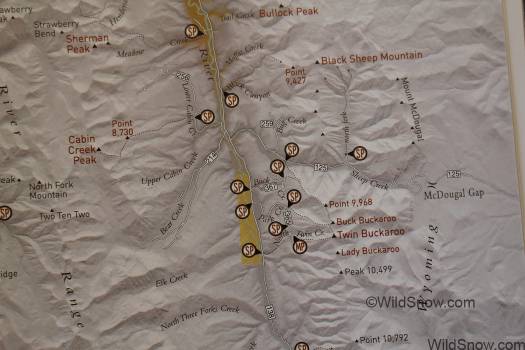It had to happen: just like the thousand dollar ski boot; the hundred dollar ski touring guidebook. With his new tome “Jackson Hole Backcountry Skier’s Guide,” author Thomas Turiano breaks just about every preconceived notion we have of ski touring guides. What’s not to love? Very little. Following, my list of pros and cons regarding that C-note you’ll consider dropping.
1. Scope. After all the hype, the movies, the repetitive verbiage about the Tetons being the “Chamonix of North America,” guess what? This 407 page magnum opus from Wyoming is NOT about the Tetons. Instead, we’re talking a huge area running about 45 miles south of Teton Pass (and a bit to the east). Comprising more than 210 summits and so many ski routes I had to stop counting after four hours and six double espressos. Topping that, many of the detailed routes yield that perfect below timberline terrain that’s made Teton Pass one of the most popular places in the country for human powered glisse. Oh, and also made it one of the most crowded places in our fine land (wait for a parking spot, anyone?).
So, implied here, use this guide and crowds will be a distant memory, like what you had for lunch in second grade.
Some routes are epic, but a quick perusal showed me quite a few options that still had good road access (though most are not “lunchtime attractions” and quite a few require approach marching). As an example of the character building type of access, if you’ve ever been in Jackson you might have gazed at the Gros Ventre mountains. Here is Turiano’s approach info for the southern Gros Ventre:
“…About 10 approach miles are required in winter and early spring — one-day trips are possible with the use of snowmobiles or snow bicycles on packed roads in Little Granite Creek, Granite Creek…”
2. This hardcover volume is not your backpack guidebook. It’s not even your dashboard guidebook. This compilation of tree wood and ink weighs three and a half pounds and costs nearly a hundred bucks. Fine by me. What you have here is the ultimate reference. No need for a website, no need for a stack of small incomplete guidebooks. Just keep this on your work table at home, mark your maps, program your GPS, and go.
I like the concept. Though I have to wonder: if Tom had simply published this mountain of information and imagery on a website and larded in some advertising, could he do better financially as well as providing a better information source? In a few more years the answer to that will become all too obvious. Ski guidebooks will port over to the web, or people will see value in the physical copy. Or both. Turiano’s book certainly gives us an example of the latter.
3. For a book this huge, natural history and cultural front material are refreshingly brief. You get about a page on wildlife, followed by a negative lecture about snowmobiles. Since snowmobile access appears to be the key for many of the routes, it would have sufficed for Turiano to advocate limiting snowmobiles to pre-used routes, and stating his opposition to “play” ‘biling. When used for access on existing trails, sleds are a tool just like an automobile. No need for panic.
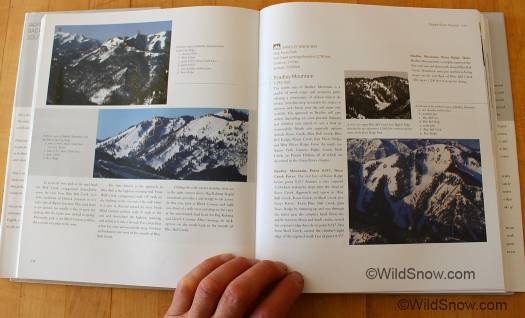
Open the book to nearly any random spread. You’ll be astounded at the prolific and nicely marked route photos.
4. I’d argue that the vast majority of ski tourers want moderate to slightly steeper mid-winter powder, not necessarily even close to a windy, cold, breakable crust coated mountain summit. Here in Colorado, our recently published guidebooks indeed have an obvious lack of suggestions for mid-winter powder terrain, that of moderate angles, perhaps with aspects and configurations that help with managing avalanche danger.
So, go to Wyoming, where Turiano delivers the powpow. Page through “Jackson Hole Backcountry Skier’s Guide” and you will experience a hunger of epic proportions for the perfect mid-winter powder skiing depicted in seemingly endless array of well labeled photos. That’s not to say you can’t find gnar within these pages. Yes you can, along with plenty of summit descents. But the winter powder options are obvious.
5. Maps. At first glance this book’s maps are stunning. At second glance you’ll notice no truly useful detail maps are provided. That’ll be up to you, perhaps by using a GPS with loaded digital maps, or paper. Interestingly, the word GPS is not even in Turiano’s index, let alone there being any GPS coordinates in his text. Another thing about Turiano’s maps is you’ll notice hundreds of little circles with the letters “SP” or “MP” on a white background. These indicate “snowmobile parking,” and demonstrate that perhaps the way to enjoy many of these routes is to begin with a snowmobile ride.
I’ve always been a fan of the unusually good snowpack at Teton Pass. Interesting stuff. Even though Wyoming weather can be frigid, they get a lot less faceting than we do here in Colorado, and overall the pack is a lot more supportive and “bridged.” While I like the snow, I’ve intensely disliked what’s happened to the parking scene at “The Pass.” In my opinion the solution (for Teton Pass as well as other places in the country) is development of additional parking near other zones — along with private sector authors such as Turiano giving complete overviews of the goods, idea being to spread people out instead of concentrate them. I bow to Turiano for his help with this. May all ski touring writers follow his lead.
At this time, “Jackson Hole Backcountry Skier’s Guide: South” is available at selected specialty retailers as well as the author’s website JacksonHoleBackcountry.com. I’d recommend this as a an excellent Christmas gift for that skier who used to have everything.
See our coverage of other Thomas Turiano books etc.
Also, check out Turiano’s books on Amazon. Thomas Turiano at Amazon
WildSnow.com publisher emeritus and founder Lou (Louis Dawson) has a 50+ years career in climbing, backcountry skiing and ski mountaineering. He was the first person in history to ski down all 54 Colorado 14,000-foot peaks, has authored numerous books about about backcountry skiing, and has skied from the summit of Denali in Alaska, North America’s highest mountain.

